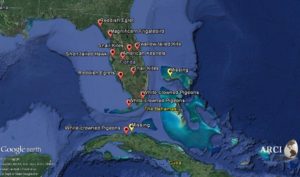Were you able to catch ARCI’s Executive Director, Dr. Ken Meyer, on a panel of researchers talking about how Hurricane Irma could have affected Florida’s imperiled species? Ken was interviewed on National Public Radio’s Science Friday on 15 September. Here’s a link to the segment, in case you missed it:


We would like to share some great news about our remotely-tracked birds that were in the path of Hurricane Irma in Puerto Rico, Cuba, the Bahamas, Jamaica, the Florida Keys, and throughout the Florida Peninsula. We are getting normal-looking movement data on all but a few of the birds! Those we have not heard from include one White-crowned Pigeon on Grand Bahama and another that had just migrated to Cuba ahead of the storm. We will keep watching for signals from these birds.
Six Gulf Coast Reddish Egrets (five in Lee County on J. N. Ding Darling National Wildlife Refuge and well north in Dixie County) stayed in place for the storm and, based on their movements compared with pre-hurricane days, appear to be doing well. The single Magnificent Frigatebird we are tracking at this time, an adult from the only U. S. breeding colony in the Dry Tortugas that spends this part of the year off the Gulf coast of Citrus County, Florida, rode out the storm over the Gulf. He headed west and then south on the cyclonic flow that eventually carried this bird along a 600-mile loop that brought it right back to its favorite near-shore roosting island.
The four satellite-tracked Snail Kites sat tight in south Florida wetlands. The same is true for the Short-tailed Hawk we recently tagged in St. Petersburg, Florida, which promptly returned to its nesting forest at Sawgrass Lake Park.
The GSM/GPS-tracked Swallow-tailed Kite Apopka had the best migratory conditions on the north winds carried in with Irma. She covered ground fast and got to the south coast of Cuba the night before the storm hit Cuba’s north coast. She remains in Cuba still today.
 |
| Location of 37 remotely-tracked birds after Hurricane Irma had passed. The two yellow “Missing” markers refer to two White-crowned Pigeons from whom we have not yet received data. |
We will be flying this week and again soon after to check on our VHF radio-tagged Southeastern American Kestrels, Snail Kites, and 12 more White-crowned Pigeons. This also will be our best opportunity to assess habitat impacts on all our study populations. We’ll also be elaborating on each species’ immediate responses to Hurricane Irma in the upcoming blog stories. We are amazed at their resilience! More soon.

Leave a Reply